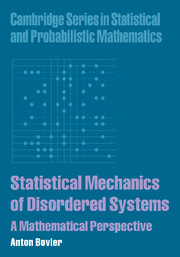Book contents
- Frontmatter
- Contents
- Preface
- Nomenclature
- Part I Statistical mechanics
- 1 Introduction
- 2 Principles of statistical mechanics
- 3 Lattice gases and spin systems
- 4 Gibbsian formalism for lattice spin systems
- 5 Cluster expansions
- Part II Disordered systems: lattice models
- Part III Disordered system: mean-field models
- References
- Index
2 - Principles of statistical mechanics
Published online by Cambridge University Press: 25 January 2010
- Frontmatter
- Contents
- Preface
- Nomenclature
- Part I Statistical mechanics
- 1 Introduction
- 2 Principles of statistical mechanics
- 3 Lattice gases and spin systems
- 4 Gibbsian formalism for lattice spin systems
- 5 Cluster expansions
- Part II Disordered systems: lattice models
- Part III Disordered system: mean-field models
- References
- Index
Summary
Qu'une goutte de vin tombe dans un verre d'eau; quelle que soit la loi du mouvement interne du liquide, nous le verrons bientôt se colorer d'une teinte rose uniforme et à partir de ce moment on aura beau agiter le vase, le vin et l'eau ne paraîtront plus pouvoir se séparer. Tout cela, Maxwell et Boltzmann l'ont expliqué, mais celui qui l'a vu le plus nettement, dans un livre trop peu lu parce qu'il est difficile à lire, c'est Gibbs, dans ses principes de la Mécanique Statistique.
Henri Poincaré. La valeur de la science.About 1870, Ludwig Boltzmann proposed that the laws of thermodynamics should be derivable from mechanical first principles on the basis of the atomistic theory of matter. In this context, N moles of a gas in a container of volume V should be represented by a certain number of atoms, described as point particles (or possibly as slightly more complicated entities), moving under Newton's laws. Their interaction with the walls of the container is given by elastic reflection (or more complicated, partially idealized constraint-type forces), and would give rise to the observed pressure of the gas. In this picture, the thermal variables, temperature and entropy, should emerge as effective parameters describing the macroscopic essentials of the microscopic dynamics of the gas that would otherwise be disregarded.
The ideal gas in one dimension
To get an understanding of these ideas, it is best to consider a very simple example which can be analyzed in full detail, even if it is unrealistic.
- Type
- Chapter
- Information
- Statistical Mechanics of Disordered SystemsA Mathematical Perspective, pp. 9 - 32Publisher: Cambridge University PressPrint publication year: 2006
- 1
- Cited by

